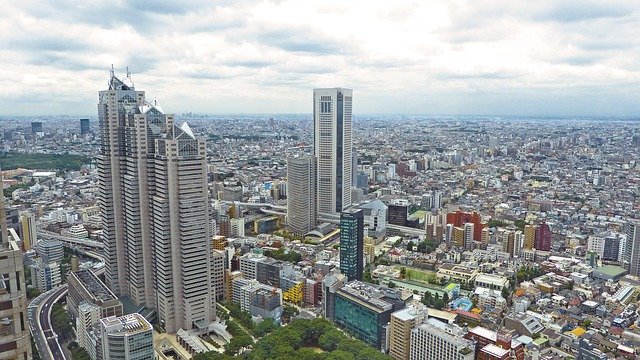Tokyo megacity
Contents |
[edit] Introduction
Megacities are metropolitan areas with a total population of more than 10 million people. The definition of what constitutes a megacity generally refers to an urban agglomeration, that is, it includes people living in the immediate suburbs outside of the established border of the city.
Megacities are a distinctly modern phenomenon, the proliferation of which has spread with large-scale urbanisation around the world. Whereas only 3% of the global population lived in cities in 1800, by the end of the 20th century that figure had risen to 47%. It is expected to reach more than 70% by the second half of the 21st century, a number made even more startling by the fact that the global population is projected to increase by two billion by that point.
Historically, the growth of big cities first occurred during the industrial revolution when large numbers of people moved to urban areas to find work - a trend broadly associated with developed nations. In contrast, contemporary megacities are focused in Asia.
[edit] Greater Tokyo Area
Tokyo was recognised along with New York as one of the first megacities when the term came into common use in the 1950s. While New York has dropped in its ranking, the Greater Tokyo Area is now the largest megacity in the world with a population of 37.4 million in 2020. For more information see: Megacities.
Ref Time Series of the Population of the 30 Largest Urban Agglomerations in 2018 Ranked by Population Size, 1950-2035. https://population.un.org/wup/Download/
Tokyo's growth has occurred despite numerous natural and human-made disasters. In 1923 the city was rocked by the Great Kanto Earthquake, and on 11 March 2011, a another major earthquake hit Japan, although Tokyo was largely spared. Much of the modern the city emerged from destruction after heavy bombing during World War II.
[edit] The megacity designation
The Greater Tokyo Area (also referred to in Japan as the Capital Region) incorporates the Kanto region (which includes the Tokyo metropolitan area along with Kanagawa, Chiba, Saitama, Ibaraki, Tochigi and Gunma) and the Yamanashi prefecture (which is part of the adjacent Chubu region). It is a major financial centre, and according to 2017 statistics, it has the largest metropolitan economy in the world.
An extensive public transit system and cycle network have helped to reduce automobile traffic and support movement throughout the region, although cycle lanes are often disregarded by delivery vehicles. The government has been investigating additional ways of reducing air pollution, traffic congestion and noise while managing crime and litter. Green initiatives (such as solar energy and tree planting) are also being introduced.
Creating a balanced urban environment has resulted in some stability in the Greater Tokyo Area, although continued growth is uncertain because of the country’s ageing population and the lack of undeveloped land in the surrounding area. People from other parts of Japan are still moving to Tokyo, in part, due to the affordability of high-rise housing built in the decades after the global economic downturn of 1991.
[edit] Tokyo and the Olympics
Construction and infrastructure work increased in the Greater Tokyo Area in the lead up to the 2020 Olympics (which has been postponed due to the 2020 Covid 19 pandemic).
The majority of the sporting venues for the Games are located in or around the Greater Tokyo Area, with several facilities repurposed from the Olympics held in Tokyo in 1964. Railway lines around the city’s airports and automated transit lines have also been developed, along with highway refurbishment to support traffic in and around the city.
[edit] Related articles on Designing Buildings Wiki
- Built environment.
- Changing lifestyles.
- Cities as systems - BRE Solutions for urban environments.
- City Beautiful.
- Densification.
- Eco towns.
- Global Construction Megacities 2017.
- Infrastructure.
- Landscape urbanism.
- Masterplanning.
- Megacity.
- Megatrends: Globalisation.
- Metro cities - the future of urbanisation.
- Must cities grow to compete?
- Smart cities.
- Urban design.
[edit] External references
- Has Tokyo reached 'peak city'? The Guardian, 14 June 2019.
- Tokyo became a megacity by reinventing itself. National Geographic, 17 February 2014.
Featured articles and news
Homes England creates largest housing-led site in the North
Successful, 34 hectare land acquisition with the residential allocation now completed.
Scottish apprenticeship training proposals
General support although better accountability and transparency is sought.
The history of building regulations
A story of belated action in response to crisis.
Moisture, fire safety and emerging trends in living walls
How wet is your wall?
Current policy explained and newly published consultation by the UK and Welsh Governments.
British architecture 1919–39. Book review.
Conservation of listed prefabs in Moseley.
Energy industry calls for urgent reform.
Heritage staff wellbeing at work survey.
A five minute introduction.
50th Golden anniversary ECA Edmundson apprentice award
Showcasing the very best electrotechnical and engineering services for half a century.
Welsh government consults on HRBs and reg changes
Seeking feedback on a new regulatory regime and a broad range of issues.
CIOB Client Guide (2nd edition) March 2025
Free download covering statutory dutyholder roles under the Building Safety Act and much more.
Minister quizzed, as responsibility transfers to MHCLG and BSR publishes new building control guidance.
UK environmental regulations reform 2025
Amid wider new approaches to ensure regulators and regulation support growth.
BSRIA Statutory Compliance Inspection Checklist
BG80/2025 now significantly updated to include requirements related to important changes in legislation.

























